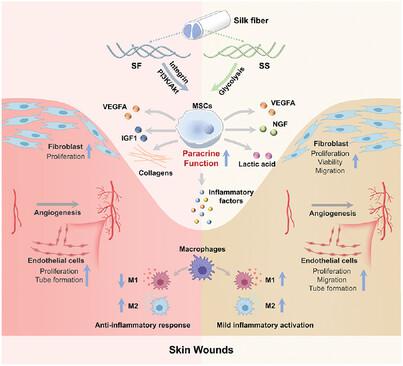当前位置:
X-MOL 学术
›
Adv. Mater.
›
论文详情
Our official English website, www.x-mol.net, welcomes your
feedback! (Note: you will need to create a separate account there.)
Silk Fibroin and Sericin Differentially Potentiate the Paracrine and Regenerative Functions of Stem Cells Through Multiomics Analysis
Advanced Materials ( IF 27.4 ) Pub Date : 2023-03-13 , DOI: 10.1002/adma.202210517 Yanan Zhang 1 , Renwang Sheng 1 , Jialin Chen 1, 2, 3 , Hongmei Wang 1 , Yue Zhu 1 , Zhicheng Cao 1, 4 , Xinyi Zhao 1 , Zhimei Wang 5 , Chuanquan Liu 1 , Zhixuan Chen 1 , Po Zhang 1, 4 , Baian Kuang 1 , Haotian Zheng 1 , Chuanlai Shen 1 , Qingqiang Yao 3, 4 , Wei Zhang 1, 2, 3
Advanced Materials ( IF 27.4 ) Pub Date : 2023-03-13 , DOI: 10.1002/adma.202210517 Yanan Zhang 1 , Renwang Sheng 1 , Jialin Chen 1, 2, 3 , Hongmei Wang 1 , Yue Zhu 1 , Zhicheng Cao 1, 4 , Xinyi Zhao 1 , Zhimei Wang 5 , Chuanquan Liu 1 , Zhixuan Chen 1 , Po Zhang 1, 4 , Baian Kuang 1 , Haotian Zheng 1 , Chuanlai Shen 1 , Qingqiang Yao 3, 4 , Wei Zhang 1, 2, 3
Affiliation

|
Silk fibroin (SF) and sericin (SS), the two major proteins of silk, are attractive biomaterials with great potential in tissue engineering and regenerative medicine. However, their biochemical interactions with stem cells remain unclear. In this study, multiomics are employed to obtain a global view of the cellular processes and pathways of mesenchymal stem cells (MSCs) triggered by SF and SS to discern cell–biomaterial interactions at an in-depth, high-throughput molecular level. Integrated RNA sequencing and proteomic analysis confirm that SF and SS initiate widespread but distinct cellular responses and potentiate the paracrine functions of MSCs that regulate extracellular matrix deposition, angiogenesis, and immunomodulation through differentially activating the integrin/PI3K/Akt and glycolysis signaling pathways. These paracrine signals of MSCs stimulated by SF and SS effectively improve skin regeneration by regulating the behavior of multiple resident cells (fibroblasts, endothelial cells, and macrophages) in the skin wound microenvironment. Compared to SS, SF exhibits better immunomodulatory effects in vitro and in vivo, indicating its greater potential as a carrier material of MSCs for skin regeneration. This study provides comprehensive and reliable insights into the cellular interactions with SF and SS, enabling the future development of silk-based therapeutics for tissue engineering and stem cell therapy.
中文翻译:

丝素蛋白和丝胶通过多组学分析差异增强干细胞的旁分泌和再生功能
丝素蛋白 (SF) 和丝胶蛋白 (SS) 是蚕丝的两种主要蛋白质,是极具吸引力的生物材料,在组织工程和再生医学方面具有巨大潜力。然而,它们与干细胞的生化相互作用仍不清楚。在这项研究中,采用多组学来全面了解由 SF 和 SS 触发的间充质干细胞 (MSC) 的细胞过程和通路,以在深入、高通量的分子水平上辨别细胞-生物材料相互作用。综合 RNA 测序和蛋白质组学分析证实,SF 和 SS 启动广泛但不同的细胞反应,并增强 MSCs 的旁分泌功能,这些功能通过差异激活整合素/PI3K/Akt 和糖酵解信号通路来调节细胞外基质沉积、血管生成和免疫调节。SF 和 SS 刺激的 MSCs 的这些旁分泌信号通过调节皮肤伤口微环境中多种常驻细胞(成纤维细胞、内皮细胞和巨噬细胞)的行为,有效地改善皮肤再生。与SS相比,SF在体外和体内表现出更好的免疫调节作用,表明其作为MSCs载体材料的皮肤再生潜力更大。这项研究为细胞与 SF 和 SS 的相互作用提供了全面而可靠的见解,使组织工程和干细胞疗法的基于丝的疗法的未来发展成为可能。SF 在体外和体内均表现出更好的免疫调节作用,表明其作为 MSCs 的载体材料具有更大的皮肤再生潜力。这项研究为细胞与 SF 和 SS 的相互作用提供了全面而可靠的见解,使组织工程和干细胞疗法的基于丝的疗法的未来发展成为可能。SF 在体外和体内均表现出更好的免疫调节作用,表明其作为 MSCs 的载体材料具有更大的皮肤再生潜力。这项研究为细胞与 SF 和 SS 的相互作用提供了全面而可靠的见解,使组织工程和干细胞疗法的基于丝的疗法的未来发展成为可能。
更新日期:2023-03-13
中文翻译:

丝素蛋白和丝胶通过多组学分析差异增强干细胞的旁分泌和再生功能
丝素蛋白 (SF) 和丝胶蛋白 (SS) 是蚕丝的两种主要蛋白质,是极具吸引力的生物材料,在组织工程和再生医学方面具有巨大潜力。然而,它们与干细胞的生化相互作用仍不清楚。在这项研究中,采用多组学来全面了解由 SF 和 SS 触发的间充质干细胞 (MSC) 的细胞过程和通路,以在深入、高通量的分子水平上辨别细胞-生物材料相互作用。综合 RNA 测序和蛋白质组学分析证实,SF 和 SS 启动广泛但不同的细胞反应,并增强 MSCs 的旁分泌功能,这些功能通过差异激活整合素/PI3K/Akt 和糖酵解信号通路来调节细胞外基质沉积、血管生成和免疫调节。SF 和 SS 刺激的 MSCs 的这些旁分泌信号通过调节皮肤伤口微环境中多种常驻细胞(成纤维细胞、内皮细胞和巨噬细胞)的行为,有效地改善皮肤再生。与SS相比,SF在体外和体内表现出更好的免疫调节作用,表明其作为MSCs载体材料的皮肤再生潜力更大。这项研究为细胞与 SF 和 SS 的相互作用提供了全面而可靠的见解,使组织工程和干细胞疗法的基于丝的疗法的未来发展成为可能。SF 在体外和体内均表现出更好的免疫调节作用,表明其作为 MSCs 的载体材料具有更大的皮肤再生潜力。这项研究为细胞与 SF 和 SS 的相互作用提供了全面而可靠的见解,使组织工程和干细胞疗法的基于丝的疗法的未来发展成为可能。SF 在体外和体内均表现出更好的免疫调节作用,表明其作为 MSCs 的载体材料具有更大的皮肤再生潜力。这项研究为细胞与 SF 和 SS 的相互作用提供了全面而可靠的见解,使组织工程和干细胞疗法的基于丝的疗法的未来发展成为可能。





















































 京公网安备 11010802027423号
京公网安备 11010802027423号